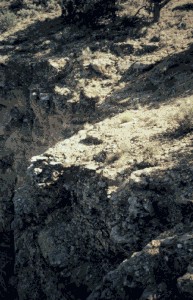Canyon rims on Kaibab Limestone in small shallow drainages or depressions caused by collapsed breccia pipes in limestone chips or conglomerate.
- Average annual precipitation (Sellers and Hill 1974): 11.4 inches (Tuweep) 14.46 inches (Grand Canyon National Park, South Rim)
- Average frost-free season (Sellers and Hill 1974): 273 days (Tuweep) 197 (Grand Canyon National Park, South Rim)
- Physiographic Province: Grand Canyon Section of the Colorado Plateau Province.
- Elevation: 1371 to 2286m (4,500 - 7,500 feet)
- Slope (%): on level to 90º
- Aspect: East to north-west facing slopes
- Parent material: Kaibab Limestone in limestone and red clay soils of the Timpoweap Member of the Moenkopi Formation. Plants grow in breccia pipes.
- Soil texture: Gravelly soil, limestone conglomerate, breccia pipes, and thin sandy-gravelly soils with limestone chips or pebbles overlying Kaibab limestone bedrock.
- Soil pH: 7.5 to 8.0
- Dept of litter: 0-3 cm
- NRCS Soil Map Unit: "135" the Mellenthin Family Rock Outcrop Complex (Lindsay in preparation). The Twin Point area soil profile is fine textured argillic and well-formed calcic horizons of the Bilburc soil (fine, smectitic, vertic paleustolls with 60% coverage of chert gravel). The Kanab Plateau at Kanab Point and SB Point is located in the lower part of the Fossil Mountain Member of the Kaibab Formation
- 1. Vegetation: Great Basin sagebrush and Pinyon-juniper woodland. 2. Biotic Community: Great Basin Conifer Woodland and Great Basin Desert scrub. 3. Dominant associated species: Listed in Arizona Game and Fish Department Plant Abstract to grow with Pinus monophylla, Juniperus osteosperma, Artemisia tridentata, and Coleogyne ramosissima. At Fishtail Mesa, associated with Fendlera rupicola, Artemisia spp., Eriogonum spp., Shepherdia rotundifolia, Amelanchier utahensis, Fraxinus cuspidata macropetala, Phlox austromontana, Ephedra torreyana, and Purshia mexicana. At Kanab Canyon, associated with Purshia stansburiana, Berberis fremontii, Fallugia paradoxa, and Yucca baccata. At Twin Point, associated with Yucca baccata, Poa fendleriana, Penstemon linarioides, Ephedra nevadensis, Gutierrezia sarothrae, Purshia stansburiana, Coleogyne ramosissima, and Juniperus osteosperma. At Dutton Point, associated with Artemisia tridentata, Purshia stansburiana, Calochortus nuttallii, Festuca arizonica, Pinus edulis, Juniperus osteosperma. At Havasupai Point, associated with Gutierrezia sarothrae, Arabis spp, Festuca arizonica, Artemisia tridentate, Ephedra spp, Juniperus osteosperma, Amelanchier utahensis, Pinus edulis, Eriogonum spp.
- Other Threatened/Endangered species: None in vicinity of known population sites.

Click on the image for a larger picture.